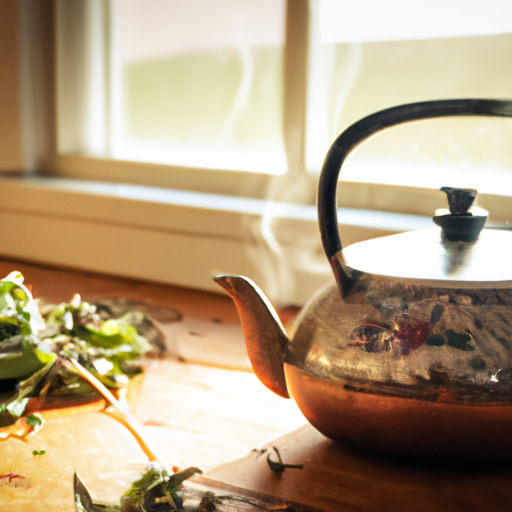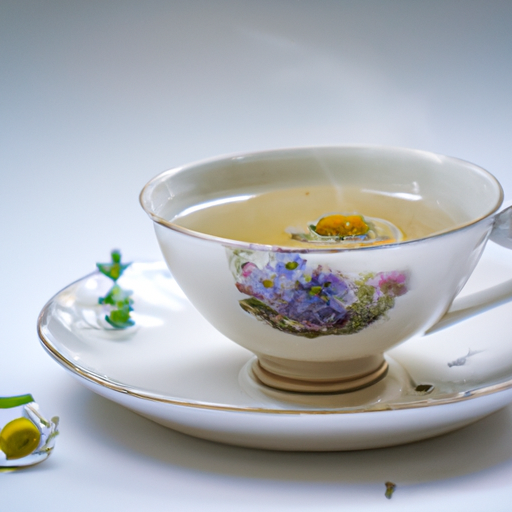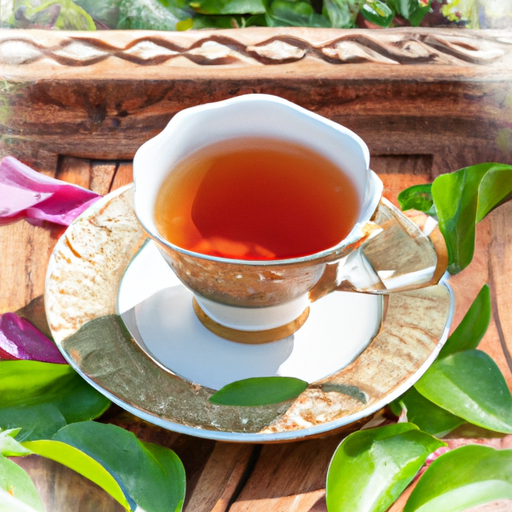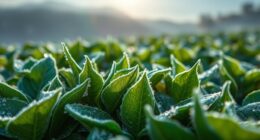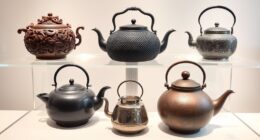Did you know that herbal tea has been enjoyed for centuries due to its numerous health benefits? In fact, studies have shown that herbal tea can help with digestion, boost the immune system, and even improve sleep quality.
But, in order to ensure that you are getting the most out of your herbal tea, there are a few key steps to follow. First, it’s important to choose high-quality herbs to ensure maximum flavor and potency. Then, make sure to store your herbs properly to maintain their freshness. Using fresh, filtered water and finding the right brewing temperature are also crucial in extracting the full benefits of the herbs. And don’t forget to steep for the right amount of time!
Finally, experimenting with different brewing methods and enhancing the flavor with natural sweeteners or citrus can take your herbal tea experience to the next level.
So, let’s dive in and discover how to ensure the perfect cup of herbal tea.
Key Takeaways
- Choose high-quality herbs that are vibrant and free from discoloration.
- Source herbs from reputable suppliers or grow them organically.
- Harvest herbs at the right time to ensure maximum potency.
- Store herbs in airtight containers away from heat and sunlight to maintain their quality.
Choose High-Quality Herbs
When choosing high-quality herbs for your herbal tea, make sure to look for vibrant, fragrant leaves that are free from any discoloration or signs of wilting. This is crucial to maximize the flavor and ensure a delicious cup of tea.
To avoid common mistakes, it’s important to source your herbs from reputable suppliers or grow them yourself using organic methods. When herbs are grown in ideal conditions, they develop their full flavor potential. Additionally, harvesting herbs at the right time, when their essential oils are at their peak, ensures a more potent and flavorful brew.
Proper storage is also essential to maintain the quality of your herbs. Store them in airtight containers away from heat and sunlight to preserve their freshness and aroma.
By following these guidelines, you can ensure that your herbal tea is of the highest quality and bursting with flavor.
Store Your Herbs Properly
To properly store your herbs, make sure you keep them in a cool, dry place to preserve their freshness and flavor. Proper storage is crucial in maintaining the quality of your herbal tea. When exposed to heat, humidity, or sunlight, herbs can lose their potency and flavor.
To prevent this, store your herbs in airtight containers or jars, away from direct sunlight and moisture. A pantry or cupboard is an ideal location as it provides a cool and dark environment. Avoid storing herbs near the stove or oven, as the heat can degrade their quality.
Additionally, make sure to label your containers with the herb’s name and date of purchase to track their freshness. By following these storage guidelines, you can ensure that your herbal tea retains its maximum freshness and flavor.
Use Fresh, Filtered Water
For the best results, make sure you’re using fresh, filtered water when brewing your cup of herbal goodness. Using herbal tea for skincare has become increasingly popular, as different blends offer various benefits for the skin. Whether you’re looking to soothe inflammation, hydrate dry skin, or fight aging signs, herbal tea can be a great addition to your skincare routine. To ensure the maximum potency and flavor of your herbal tea, the quality of water you use is crucial. Filtered water removes impurities and chemicals that can affect the taste and overall effectiveness of the tea. By using fresh, filtered water, you’re providing the herbs with the cleanest canvas to infuse their beneficial compounds into your cup.
To help you explore different herbal tea blends for skincare, here’s a table showcasing some popular options:
| Herbal Tea Blend | Benefits for Skincare |
|---|---|
| Chamomile | Soothes inflammation, calms sensitive skin |
| Green Tea | Provides antioxidants, promotes youthful skin |
| Rooibos | Hydrates and nourishes dry skin |
| Lavender | Helps reduce redness and irritation |
By incorporating these blends into your skincare routine, you can harness the power of nature to promote healthy, glowing skin. Remember, using fresh, filtered water is a small but important step in ensuring the best results from your herbal tea.
Find the Right Brewing Temperature
Discovering the perfect brewing temperature is like finding the key to unlocking the full potential of your cup, creating a symphony of flavors that dance on your taste buds.
When it comes to herbal tea, the right brewing temperature can make all the difference in the taste and aroma of your brew. Experimenting with alternative temperatures can lead to surprising results.
Different herbs release their flavors at different temperatures, so it’s important to understand the impact of temperature on flavor. For example, some delicate herbs, like chamomile, are best brewed at lower temperatures around 175°F to preserve their subtle floral notes. On the other hand, robust herbs like peppermint can handle higher temperatures around 212°F, allowing their bold flavors to shine.
By adjusting the brewing temperature, you can truly customize your herbal tea experience and discover a whole new world of flavors.
Steep for the Right Amount of Time
Achieving the perfect balance of flavors in your brew requires steeping the herbs for just the right amount of time. This crucial step in the brewing process allows the herbs to release their unique flavors and benefits into the tea. To ensure the best results, follow these brewing techniques:
-
Refer to the instructions: Different herbal teas require different steeping times. Read the packaging or consult a trusted source for guidance on the ideal steeping time.
-
Experiment with shorter steeping times: Some delicate herbal teas can become bitter if steeped for too long. Start with a shorter steeping time and gradually increase it until you find your desired flavor profile.
-
Use a timer: To avoid over-steeping, set a timer to keep track of the exact time your tea has been steeping.
-
Try different blends: The best herbal tea blends may require specific steeping times to bring out their unique flavors. Explore different blends and experiment with steeping times to discover your favorite combinations.
By mastering the art of steeping for the right amount of time, you can unlock the full potential of your herbal tea and enjoy a truly satisfying brew.
Experiment with Different Brewing Methods
Don’t be afraid to get creative and try out various brewing methods to truly unleash the potential of your favorite herbal concoctions.
Different tea flavors can be enhanced by experimenting with different brewing techniques. For example, if you’re looking to bring out the delicate floral notes of chamomile tea, try steeping it in water that’s just come off the boil for about 5 minutes.
On the other hand, if you prefer a stronger and more robust flavor, you can try using a French press to brew your herbal tea. This method allows for a longer steeping time, resulting in a bolder taste.
Additionally, you can also explore cold brewing methods for a refreshing and unique twist on your herbal tea experience.
So go ahead and explore the wonderful world of different tea flavors and brewing techniques to find your perfect cup of herbal bliss.
Enhance the Flavor with Natural Sweeteners or Citrus
To elevate the taste of your herbal infusion, consider incorporating natural sweeteners or a hint of citrus to add a delightful touch of complexity. Enhancing herbal tea with honey is a popular choice that not only adds sweetness but also brings its own unique flavors that complement different herbal blends. Honey has been used for centuries as a natural sweetener and has a pleasant taste that pairs well with various herbs.
Additionally, trying different herbal tea blends can also enhance the flavor of your infusion. Each herb has its own distinct flavor profile, and experimenting with different combinations can create a more interesting and enjoyable tea experience.
So, whether you choose to sweeten your herbal tea with honey or experiment with different blends, these simple additions can take your herbal infusion to the next level of flavor.
Enjoy the Benefits of Herbal Tea for Your Health
Experience the amazing health benefits of herbal infusions and enhance your well-being with every sip. Herbal tea is not only a delicious and comforting beverage, but it can also provide numerous benefits for your health.
One of the popular uses of herbal tea is for relaxation. Certain herbs like chamomile and lavender have calming properties that can help reduce stress and promote a sense of tranquility.
Additionally, herbal teas can also aid in digestion. Peppermint and ginger teas, for example, have been traditionally used to soothe stomach discomfort and promote healthy digestion. These herbal infusions can help alleviate symptoms such as bloating, indigestion, and nausea.
So, next time you reach for a cup of tea, consider choosing an herbal blend that can not only satisfy your taste buds but also support your overall well-being.
Frequently Asked Questions
Can I use tap water instead of filtered water for brewing herbal tea?
Using tap water vs filtered water for brewing herbal tea: which is better? As the saying goes, "You get what you pay for." Filtered water is recommended for better taste and to ensure the maximum health benefits of herbal tea.
What are some common natural sweeteners that can be used to enhance the flavor of herbal tea?
Using natural sweeteners in herbal tea can enhance the flavor. Common options include honey, stevia, and maple syrup. To balance the flavors, start with a small amount and gradually add more if needed. Experimentation is key!
How can I determine the right brewing temperature for different types of herbal tea?
To determine the right brewing temperature for different types of herbal tea, I recommend referring to a brewing guide. Each tea has its own optimal temperature, ranging from 175°F for delicate teas to 212°F for more robust varieties. Proper brewing techniques ensure a flavorful cup.
Are there any specific herbs that should be avoided for brewing herbal tea?
There are certain herbs that should be avoided for brewing herbal tea due to potential side effects. Some examples include comfrey, pennyroyal, and sassafras. It is important to research and consult with a healthcare professional before using any herbs in tea.
Can I reuse the herbs for a second steeping or should I discard them after the first use?
You can reuse herbs for a second steeping when making herbal tea, but it depends on the variety of herbs used. Some herbs lose their flavor after the first use, while others can be steeped multiple times.
Conclusion
As I take a sip of my freshly brewed herbal tea, I’m reminded of the care and precision that went into every step of the brewing process. Each herb was carefully chosen for its quality and stored in airtight containers to preserve its freshness.
The water used was pure and filtered, ensuring that no impurities tainted the delicate flavors. The tea steeped at the perfect temperature, allowing the herbs to release their beneficial properties.
I experimented with different brewing methods, unlocking new depths of flavor. And now, as I enjoy this aromatic and soothing drink, I’m reaping the numerous health benefits that herbal tea has to offer.

